#ryuteki
Text
Hotsui Matsuri Day 5 - More Traditional Japanese Instruments
It's the final day of Hotsui Matsuri! And we're talking about more traditional Japanese Instruments!
#hotsuimatsuri #aniblogger
How are we already at day five? Hotsui Matsuri is coming to a close today and we’ve already been there and back again to our local Obon Festival to do some Bon Odori. So today, at the end of the day, I’m here to sit down and talk about some more traditional Japanese Instruments; because if there’s one thing we can all join together with and understand–it’s music.
Kagura Suzu
This Japanese…

View On WordPress
#aniblogger#anime#bamboo flute#den den daiko#festival season#hand drum#hotsui matsuri#instruments#japanese#japanese culture#kagura dance#kagura suzu#kugo#music#ryuteki#shinto instruments#traditional Japanese Instruments#vertical harp
1 note
·
View note
Text
Demon Slayer Oc: Rinne

(long post below)
ʙ ᴀ s ɪ ᴄ s
✿ ғɪʀsᴛ ɴᴀᴍᴇ :
(Rinne | 倫音)
(倫- Meaning ‘Ethics/Morals/Principles and 音- Meaning Sound/Noise)
✿ ʟᴀsᴛ ɴᴀᴍᴇ :
(her mother refused to give her the last name out of shame, but her grandfather took her in anyways- Her family name is Kondou | 近藤)
(近藤 Meaning Near/close and Kudzu)
✿ ɴɪᴄᴋɴᴀᴍᴇ :
(None)
(None)
✿ ᴄᴜʀʀᴇɴᴛ ᴀɢᴇ :
(13-17)
✿ ʙɪʀᴛʜᴅᴀʏ :
(April 19th)
✿ ɢᴇɴᴅᴇʀ :
(Female)
✿ sᴘᴇᴄɪᴇs :
(Human)
✿ ʀᴀɴᴋ :
(Hinoe + Tsugoku)
✿ ʀᴇʟᴀᴛɪᴏɴsʜɪᴘ sᴛᴀᴛᴜs :
(Complicated)
✿ ᴇᴛʜɴɪᴄɪᴛʏ :
(Japanese mother + European father)
✿ ᴅᴏᴍɪɴᴀɴᴛ ʜᴀɴᴅ :
(Right hand)
✿ ʙʟᴏᴏᴅ ᴛʏᴘᴇ :
(0+)
_____________________________
✿
ᴀ ᴘ ᴘ ᴇ ᴀ ʀ ᴀ ɴ ᴄ ᴇ
✿ ᴇʏᴇs :
(Cobalt Blue | Down-turned hooded)
✿ ʜᴀɪʀ :
(Slightly curly hair | Dark purple-ish brown/black | two strips of orange | Bangs with short hair in the back but a long braid)
✿ sᴋɪɴ :
(Light skin | Keratosis Pilaris)
✿ ʜᴇɪɢʜᴛ ᴀɴᴅ ᴡᴇɪɢʜᴛ :
(164 cm)
(117 lbs)
✿ ᴀᴛᴛɪʀᴇ :
(Demon slayer uniform with long skirt, white boots + belt, white under shirt and a Haori that's pale green, white and amber flecks)
✿ sᴄᴇɴᴛ :
(Something in between cedar and Vetiver)
(Cedar is a woody scent with citrus undertones and Vetiver is earthy, woody and notes of floral)
________________________________
✿
ᴘ ᴇ ʀ s ᴏ ɴ ᴀ ʟ ɪ ᴛ ʏ
✿ ᴏᴘᴛɪᴍɪsᴛɪᴄ ᴏʀ ᴘᴇssɪᴍɪsᴛɪᴄ :
(Pessimistic)
✿ ɪɴᴛʀᴏᴠᴇʀᴛ ᴏʀ ᴇxᴛʀᴏᴠᴇʀᴛ :
(Introvert)
✿ ʟᴏɢɪᴄᴀʟ ᴏʀ ᴇᴍᴏᴛɪᴏɴᴀʟ :
(Emotional)
✿ sᴇʀɪᴏᴜs ᴏʀ sᴀʀᴄᴀsᴛɪᴄ :
(Serious)
✿ ʟᴇᴀᴅᴇʀ ᴏʀ ғᴏʟʟᴏᴡᴇʀ :
(Follower)
✿ ᴄᴏɴғᴅɪᴇɴᴛ ᴏʀ ɪɴsᴇᴄᴜʀᴇ :
(Insecure)
_________________________________
✿ ᴏᴠᴇʀᴀʟʟ ᴘᴇʀsᴏɴᴀʟɪᴛʏ :
(Rinne is a soft and gentle person on the exterior. She’s sweet, sensitive, loyal, and generous. But she’s also adventurous, proud, artistic, impulsive, and excitable once she’s comfortable around someone. Despite being a high-ranking demon slayer (and climbing the ranks fast) She’s not very brave. She’s rather impulsive and goes to things head on and fills herself with adrenaline enough to stifle her fear until after the battle. So instead of using bravery in fights she mostly relies on her impulsiveness, adrenaline, and determination. She also chooses to fight demons for helping people rather than taking joy out of killing demons. She can sometimes be rather forgetful or lazy at times.)
✿ ᴘᴏsɪᴛɪᴠᴇ ᴄʜᴀʀᴀᴄᴛᴇʀɪsᴛɪᴄs :
﹥HIGHLY empathetic
﹥Humble
﹥Generous
✿ ɴᴇɢᴀᴛɪᴠᴇ ᴄʜᴀʀᴀᴄᴛᴇʀɪsᴛɪᴄs :
﹥Impatient
﹥Impulsive
﹥Low confidence
✿ ʟɪᴋᴇs :
﹥Music
﹥Art
﹥games
✿ ᴅɪsʟɪᴋᴇs :
﹥Eating Meat (excluding seafood)
﹥Cold
﹥People touching her without asking
✿ ʜᴀʙɪᴛs :
﹥Biting her lip
﹥Humming
﹥Spinning her blade
✿ ʜᴏʙʙɪᴇs :
﹥Playing instruments (Ryuteki, Drums, Sho)
﹥Painting (body paint)
﹥Learning about anatomy/bones/pressure
__________________________
✿
ʜ ᴇ ᴀ ʟ ᴛ ʜ
✿ ᴘʜʏsɪᴄᴀʟ :
(Normal condition | But has Light Sensitivity)
✿ ᴍᴇɴᴛᴀʟ :
(ADHD and AVPD and Sensory disorders. She struggles with confidence but overall her mental healthy is average/stable)
✿ ᴀʟʟᴇʀɢɪᴇs :
(None)
✿ ᴘʜᴏʙɪᴀs :
(Thalassophobia + Tokophobia)
(Fear of large bodies of water + fear of pregnancy/birth)
___________________________
✿
s ᴛ ᴀ ᴛ ɪ s ᴛ ɪ ᴄ s
✿ ʜᴇᴀʟᴛʜ:
(7/10)
✿ sᴛᴀᴍɪɴᴀ:
(9.5/10)
✿ sᴛʀᴇɴɢᴛʜ:
(5.5/10)
✿ ᴇɴᴅᴜʀᴀɴᴄᴇ:
(6/10)
✿ sᴘᴇᴇᴅ:
(8/10)
✿ ᴀɢɪʟɪᴛʏ:
(7.8/10)
✿ ɪɴᴛᴇʟʟɪɢᴇɴᴄᴇ:
(5.5/10)
✿ ᴄᴏᴍᴍᴏɴ sᴇɴsᴇ:
(5/10)
✿ ᴡɪsᴅᴏᴍ:
(3/10)
_______________________
✿
ʀ ᴇ ʟ ᴀ ᴛ ɪ ᴏ ɴ s ʜ ɪ ᴘ s
✿ ᴍᴏᴛʜᴇʀ :
(Unnamed) | (Relationship is bad) | (No contact/alive)
✿ ғᴀᴛʜᴇʀ :
(an Unnamed foreigner) | (Never met him) | (No contact/alive)
✿ ʙʀᴏᴛʜᴇʀ/s :
(None) | (_) | (_)
✿ sɪsᴛᴇʀ/s :
(None) | (_) | (_)
✿ ᴘᴇᴛ/s :
(None) | (But she names animals that live around the Demon Slayer Corpse and at Tengens estate)
✿ ᴏᴛʜᴇʀ ɪᴍᴘᴏʀᴛᴀɴᴛ ᴘᴇᴏᴘʟᴇ :
(Her grandfather) | (Tohru Kondou)
Her grandfather raised her once she stopped breastfeeding which is when her mother gave her up.
_________________________________________
✿
ᴀ ʙ ɪ ʟ ɪ ᴛ ʏ
✿ (Her Nichirin blades are twin katanas with an amber color and green with black strokes similar to the music kanji but not quite formed as if the kanji was ‘wavy’. The sword guard is black and pale green with flecks of white and it's in the shape of a more rounded/swirled Bass Clef note. Aside from the Nichirin blade she has a Ryuteki with a secret compartment that holds a blade laced in wisteria. )
Breath:
✿( sound breathing)
(describe breathing technique)
(and similar to Sound breathing is her Music breathing which follows the same concept as sound breathing but focuses more on a sharp mind, focus, agility, more of a ‘flowy’ style and is a lot more versatile as it each form mimics a different type of music so some forms focus more on speed and agility while others focus more on strength and overpowering your opponent.)
(All forms are to be determined later.)
(list second style/move)
(describe)
(list third style/move)
(describe)
(list fourth style/move)
(Two abilities gained from both techniques are echo-location from the sound breathing. And from the music breathing she gained the ability to create a tune/song that will attract lower ranking demons while also weakening them (This currently does not work on lower or upper moons). The sound can travel far and also allows Rinne to temporarily track and assess any demons. )
_______________________
(Template found here)
_________________________________________________________
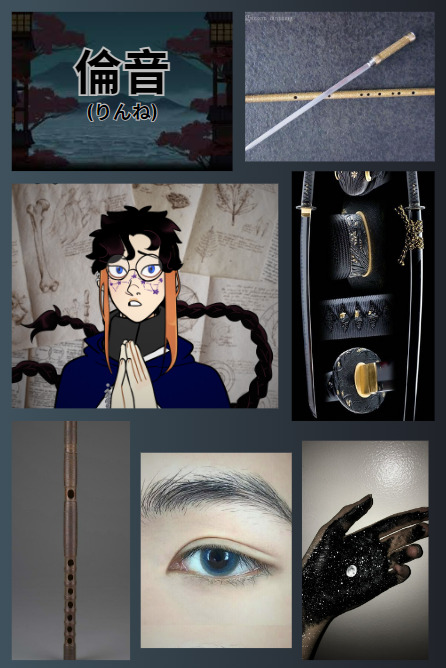

12 notes
·
View notes
Note
I've made a concept thing for her!
(Really suggest listening to this while looking it over!)
Name: Rinne (倫音) 倫-Ethic, Morals, Principles 音- Sound, Verse, News, (there where so many kanji's for Rinne, but I liked these ones the best for her characters!
Age: 14-17
Siblings: None
Pets?: None, but when she plays birds will either get closer or sing back
Parents: Rinne's mother is japanese but her father is white so as a child she was mainly kept inside with her mother or was left at her grandfathers music shop.
Rank: Tsugoku of Uzui Tengen/The sound hashira
Breathing Form: Sound Breathing + (Sub-type and under development) Music breathing
Hobbies: Music, Painting/body painting, reading, Bones/anotomy
Instruments: Ryuteki (main), Various drums, Sho
Weapons: Twin Katanas and her Ryuteki which has a secret compartment with a blade
Extra: She is soft spoken. She has sensory disorders. And she doesn't have a lot of friends, because when she was younger her family 'hid her'. Her grandfather really cared about her but her mother was ashamed of her and her father wasn't around for very long.

oooo!! I love the concept!!<333
7 notes
·
View notes
Text
Hijikata Toshizo's favorite? A bamboo flute found at the home of a descendant of his brother-in-law in Hino

Sato Fukuko holding a flute believed to have been used by Hijikata Toshizo
(Close-up photo of the flute here)
A bamboo flute (ryuteki) believed to have been the favorite flute of Hijikata Toshizo, deputy chief of the Shinsengumi, who was active in the final days of the Tokugawa shogunate, has been found in a house in Hino.
Sato Fukuko (佐藤福子), 50, a descendant of Toshizo's brother-in-law Sato Hikogoro and director of the "Sato Hikogoro Shinsengumi Museum" (2 Hinohonmachi, Hino City), found the flute in a closet at her home.
Fukuko said, "People have an image of Toshizo as a Demon Vice-Commander, but I hope people will learn that he had an unexpected side playing the flute."
Hikogoro was the husband of Toshizo's sister, Nobu, and studied Tennen Rishin-ryu with Kondo Isami, the future Commander of the Shinsengumi. After the formation of the Shinsengumi, he was known for his financial support. The Sato family still has many items related to the Shinsengumi, including a hanging scroll written by Kondo Isami and a letter written by Okita Soji.
The flute was found in October of last year when Fukuko-san was sorting through old documents and other materials stored in a closet, and found it in a Japanese-style chest. This was the first time the flute was found, and in January of this year, a newspaper article from 1951 was also found showing a photo of Fukuko's grandfather, Hitoshi (仁), holding a flute. The article's photo description read, "Hijikata's descendant Sato Hitoshi playing Hijikata's flute" which made Fukuko realize that it must have been used by Toshizo.
The flute is approximately 40 cm long. The paper sheath and the silk pouch for the flute were also wrapped in Japanese paper.
On the next day, the flute was appraised by an antique art dealer, who also found that it was most likely made in the mid-Edo period, judging from the condition of the lacquer. According to Fukuko, Hikogoro and Toshizo's older brother, Tamejiro, enjoyed joruri (traditional Japanese puppet theater), and it can be surmised that Toshizo was influenced by them and became familiar with the flute.
Yamamura Tatsuya, 45, a historical writer who was in charge of historical research for the NHK Taiga drama "Shinsengumi!," said, "I've never heard a story about Toshizo playing the flute in any document. However, the newspaper article suggests that there was a long tradition in the Sato family that Toshizo loved to play the flute. It is a highly reliable and valuable relic."
The flute will be on special display at the Sato Hikogoro Shinsengumi Museum from March 3. Admission is 500 yen for adults and 300 yen for elementary and junior high school students.
(Yomiuri Shimbun, May 3, 2007)
40 notes
·
View notes
Text
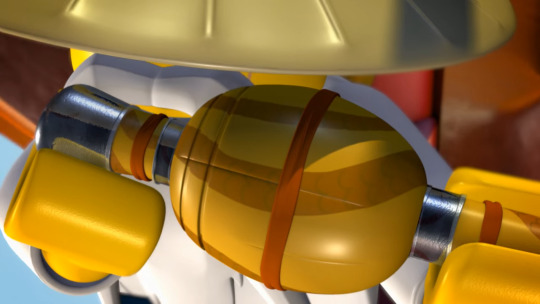
What kind of flute is this? It looks like a strange shakuhachi but it sounds like a ryuteki.
6 notes
·
View notes
Text
Tenjin Matsuri 天神祭
Today we are celebrating Tenjin Matsuri 天神祭 which literally means "The Festival of the Heavenly Gods".

The festival honors the deity of scholarship Sugawara Michizane 菅原 道真.
He was a scholar, poet, and politician of the Heian period.
He is regarded as an excellent poet, particularly in Kanshi poetry 漢詩 and is today revered in Shinto as the kami 神 of learning.
Many Shinto shrines in Japan are dedicated to him.
Michizane had an exceptional talent in both Kanshi, poetry in Chinese, and Waka, poetry in Japanese.
His primary interest was Kanshi because in those days the immersion in Chinese culture was regarded as a proof of refinement and scholarship.
Since his excellence in Kanshi was well known throughout the Court, Emperor Daigo suggested him to compile his Chinese poetry. And therefore he published Kanke Bunso 菅家文草 and dedicated it to the Emperor in 900.
After his exile he continued to work on Kanshi and compiled them into the Kanke Koshu 菅家後集 it contains 46 Kanshi and was completed sometime before his death in 903.
Tenjin Matsuri is a spectaculair festival celebrated on the 24th and 25th of July in many places around Japan.
One of the places is at Tenmangu Shrine 天満宮 at Kitaku, Osaka.
Tenmangu Shrine was built in 949 by the order of Emperor Murakami. And it's one of the many many shrines dedicated to Sugawara Michizane.
The origin of this festival dates back to 951, two years after the foundation of the shrine. When kamihoko, a portable shrine with a halberd on its top, was released into the river near the shrine and a temporary funeral hall was built at the place where the kamihoko washed ashore.
Local people who worshiped at the shrine rode on boats and welcomed the arrival of the kamihoko, which was said to mark the beginning of the festival.
The first day of the festival begins with the Yoimiya festival to pray for the success of the Hokonagashi ceremony.
It is followed by the actual ceremony in which the sacred halberd is released from the Hokonagashi bridge at the sound of a ryuteki 龍笛 flute.
On the following day the spirit of the Tenjin deity is transferred to a portable shrine called mikoshi 神輿 and paraded around for about 4km from the Tenmangu Shrine to the point of embarkation attended by as many as 3,000 festival participants. Mikoshi is then transferred onto a boat and accompanied by a 100 more river boats. While it moves towards the Naka river to the Okawa river with amazing fireworks overhead.
#tenjin matsuri#matsuri#japan festival#japansummerfestival#summer festival#summer#life in japan#art#pink aesthetic#japan travel#japan blog#japan aesthetic#fireworks#天神祭#history
3 notes
·
View notes
Text
🎸- Like Tayuya, Hana plays the flute and uses it for sound based genjutsu. Unlike Tayuya, however, Hana is more familiar with the Shakuhachi and Ryuteki than the western flute.
Her mother taught her how to play Shakuhachi as a hobby before she learned how to use genjutsu, and the logical next step was to learn how to implement illusions into the music.
3 notes
·
View notes
Text
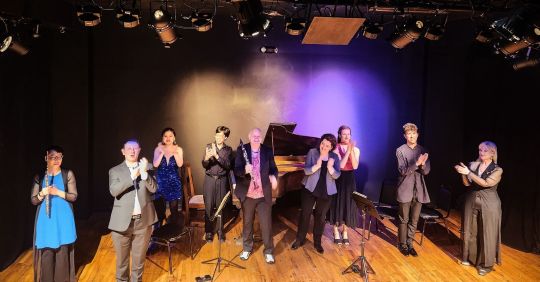
"Party time! The Queens New Music Festival Benefit is tomorrow night! As a member of the Random Access Music team, preparing FRESH/MEANINGFUL music with living composers is AMAZING! As an audience member, hearing/watching my colleagues/guest artists bring music to life and then chatting with the composers at the performance is even better!
"If you find the audience/composer/performer relationship important to you, let's hang out and make music together at our fundraiser (we're bring percussion for you to participate!) Details below:
"FB Event: https://fb.me/e/6Z9whJmoF
"https://www.simpletix.com/e/ram-queens-new-music-festival-benefit-tickets148884
"Purchase tickets online at the link above, or purchase in person at the venue on Nov. 7th.
"TUESDAY
NOVEMBER 7, 2023
7-9 pm
Culture Lab LIC
5-25 46th Ave, Queens, NY 11101
"Information: [email protected]
"A Fund-Raising Event for Random Access Music's
Queens New Music Festival 2024.
"Random Access Music invites you to join us for a special evening of live music, libations and light appetizers at Culture Lab. All proceeds from this event will go to support the 2024 Queens New Music Festival, the only event of its kind in the borough of Queens.
"The highlight of the evening will be a performance of a new piece jointly composed by RAM member composers and performed by our musicians. This exciting new piece places the musicians throughout the gallery to create a spatialized, immersive sonic environment. We’ll have rain sticks and other hand percussion and the audience is invited to join in as well!
“'RAM Sonics' (2023) (World premiere)
An interactive, collaborative composition by RAM composers Seth Boustead, Zhihua Hu, Beata Moon, and Frances White for RAM players and audience.
"RAM Players:
Lish Lindsey, flute/ryuteki
Thomas Piercy, clarinet/hichiriki
Zichao Liu, trumpet
Seth Gilman, voice
Frances White, electronics
Seth Boustead, percussion
Zhihua Hu, percussion
Beata Moon, percussion
"Attendees are also encouraged to explore the current exhibit at Culture Lab LIC at The Plaxall Gallery: Tess Howsam’s 'The Inevitability of Absence' included with your ticket.
"Music | Raffles | Food | Drinks*
"Cost: $25 per person
*Soft drinks included. Beer and wine available for purchase."
h/t Lish Lindsey
1 note
·
View note
Photo

My colleague's mother will take her kimono's obi belt to clean (arai hari 洗い張り literally translated as "wash" and "stretch"). After many years of wearing her favorite obi, it has become soiled so she has deconstructed the obi to take to a special cleaner. After it is cleaned, it will be sown back into its original form or if there are stains, then they will sew it so that the stain would not show as much. Kimonos are also cleaned in the same way. They take out all the stitches, cleaned, refitted then sewn back to together again. the material for obi and kimonos are never cut and can be made into a roll of fabric again, allowing it to be reused over and over. This particular obi has an interesting embroidery on it. there is the family crest (kamon), but it is probably an "ura kamon" which is said to be passed from a mother to her daughters but I am not quite sure about that. The season is when the cherry blossoms are blooming and 2 of the 3 wind instruments that are used for Gagaku (music of the Imperial court) is shown-Top left is the Sho (笙). The Sho is suppose to look like a phoenix and it sound expresses a ray of heavenly light. The bottom right is instrument called Ryuteki (龍笛)that is suppose to express the sound of a dragon flying. Could you imagine viewing cherry blossoms while listening to traditional Japanese music? #kimono #obibelt #gagaku #ryuteki #着物 #vintage #japanesetextiles #帯留め #embroidery #กิโมโน #kainjepun #키모노 https://www.instagram.com/p/BvTuDrRnuhr/?utm_source=ig_tumblr_share&igshid=18fkxk7xwm0xx
1 note
·
View note
Text
Sakura and Ayato’s children

Crown Prince Haruki has the quiet nature of Ayato, but there is a soft strength to it that reminds many of Sakura that makes him capable and commanding without being as intimidating as the king. Smart and charismatic, the prince spent 4 years Nesshin for military training and developed a knack for sword play and strategy. He also has a talent for music, and plays the ryuteki
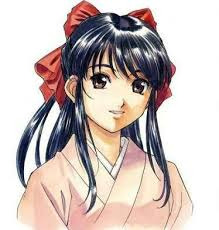
The outspoken princess Tsubaki is trained in the sword, which made Fujimaru bluster bright red when he first saw the small girl walking around with a bokken, but it was something that she wanted to do, and Ayato felt it was good for a princess to explore the things they were interested in, as opposed to being forced into a role they don't want. He said it openly, eyes boring into the former king, who at that moment decided to remain silent. She's quick witted and eloquent, and hopes to grow up like her uncle Akira, traveling as a diplomat to help her big brother when he becomes king.

Princess Kikyou is a gentle heart much like Sakura. Well versed in flower arrangements and the arts, she is known for her poetry and drawing, and plays the koto much her mother the Queen. She is also in charge of organizing any events for the various festivals throughout the year, and gladly performs the prayer dance during the Blossom Festival. She also is quite sharp, with a passion for history, and will pen a few historical texts of her own, as well as a collection of haiku.
3 notes
·
View notes
Text
MHRise Music Interview
I am sure an official English one will be made available soon, but Capcom released an interview with the Sound Director and Lead Composer for MHRise that I wanted to share. Here is some fan translations of it for now:
Ref: https://www.facebook.com/MHRiseJP/posts/212575780589186
Recap from sound/music interview.
Kosuke Tanaka (Sound Director)
Satoshi Hori (Lead Composer)
Introduce your job:
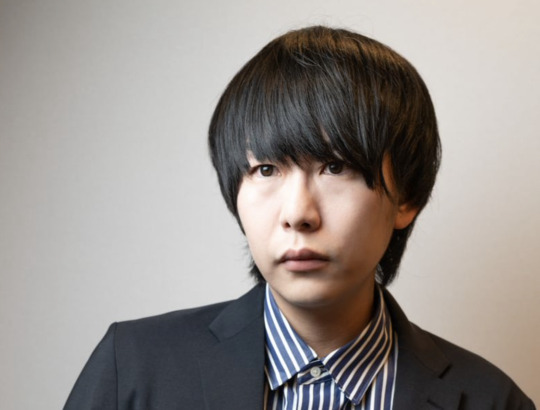
Tanaka: I am in charge of sound direction, review, and schedule management. I create sounds as well, like the Wirebug movement sounds, title logo sound effect, etc.

Hori: I am the lead composer, in charge of overall music direction, musical concepts for each monster’s themes (instruments, scope, etc.) and work with the other composers on the game.
What was the direction for the sound design?
Tanaka: Something catchy and easy to understand. The design for iceborne was nuanced and layered, but for Rise we wanted it to be something that felt familiar at first listen. We make a huge effort to respect the roots of the franchise sound and we have a lot of old sounds mixed in with the new ones as well.
The sounds in the TGS trailer featured stuff like bird cries in the distance. How did you do those?
Tanaka: We did a lot of field recordings to make it sound realistic. Stuff like wild birds, ambient noise in caves, old temple bells, etc. We recorded a lot.

We heard a lot of diff. Instruments in the music in the trailer.How did you go about recording it?
Hori: We used a ton of diverse instruments, from shakuhachi to shamisen, shinobue, and of course koto, biwa and hichiriki, ryuteki, taiko, kagura suzu, conch shells, etc. so a lot of familiar but also exotic sounds as well. We didn't just use Japanese instruments, we also use orchestra which really nails that monster hunter feel and lets us greatness of the monsters. We recorded in various locations like Japan, LA, and London. The large scale monster orchestrations were done mainly at Abbey Road Studios in London. In this game we have more than just instrumental music, we have different types of songs as well.
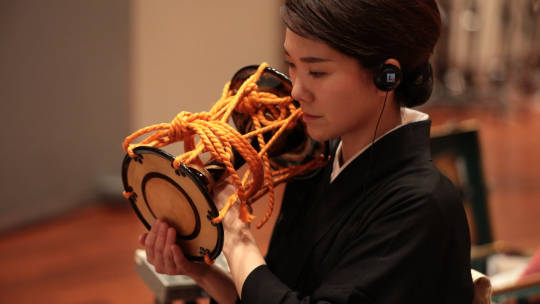
How did you add chorus/singers to the special MHRise ver. Of Proof of a Hero?
Hori: We used a 24-person chorus. Combined with Japanese instruments, and orchestra, it makes for a very unique version of the song. The song is meant to bring inspiration and drive to the hunter as they work to protect the people of Kamura from the Rampages. There are places in the song with the theme of both Kamura Village and the Rampage play, so see if you can spot that.
How did you handle monster theme songs?
Hori: We didn’t do anything massively different as this should stay true to the series, but we did arrange them to be quite catchy and unique.
Ichinose: We decided to add “voice” to each song so even monster themes from past games have been arranged in a way that has some sort of vocal element.
The hunters talk in this game. How many variations of voice can you choose from?
Tanaka: I won’t go into specific numbers so you’ll have to look forward to the finished game for that, but there are plenty of choices, enough to make you stop and think. We have more than just reaction voices, we have actual lines of dialogue, so we tried to express different personalities with each variation we recorded. The scenario writer came up with a script with many different lines and we think it turned out great and the voices really make you feel the hunter is a real character with their own way of life and approach to things.
On top of that, we did Japanese, English, and Monster Hunter language for them so it’s really hard to decide the voice for your hunter!
Why did you decide to have hunters talk?
Tanaka: We wanted hunter dialogue to be part of a way hunters communicate together. With the portable games up until now, everyone got together and could talk to each other, and we wanted to capture that busy and energetic social atmosphere in this game. We feel hunter voices will produce a similar effect. This also removes the need for voice chat or other companion apps so it lowers the communication hurdle for many hunters.
For online, how will that work with the different players around the world communicating together?
Tanaka: The dialogue will play in the language the player has selected even if the other players are not set to the same language. This will help players from all over the world communicate and play together. You can turn the voices on/off if you like of course.
Hope you liked that!
-Gaijinhunter
69 notes
·
View notes
Photo
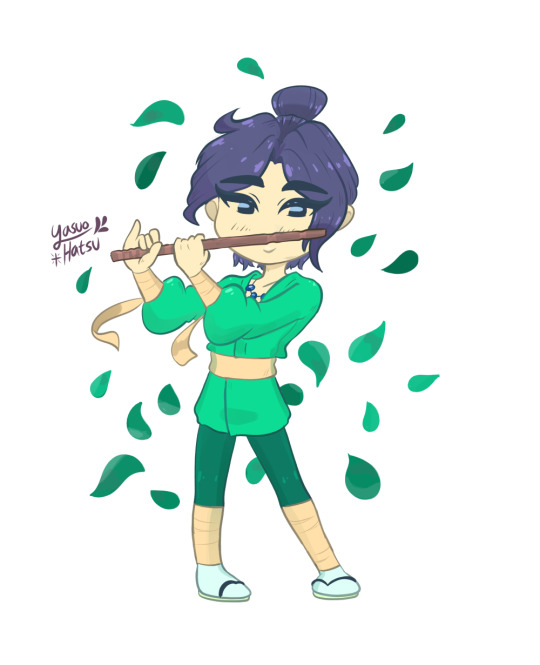
Chibi Yasuo playing the ryuteki all peacefully! Admire his angelic tune!
8 notes
·
View notes
Video
Pieza de #ryūteki https://www.facebook.com/ryuteki/ #ryuteki #gagaku #Japón #músicajaponesa #japanesemusic #japóntradicional #flautas #vientos #instrumentosdeviento #bunka #japones #japonantiguo
#japón#bunka#japóntradicional#ryuteki#vientos#ryūteki#instrumentosdeviento#japones#japonantiguo#flautas#gagaku#japanesemusic#músicajaponesa
0 notes
Photo

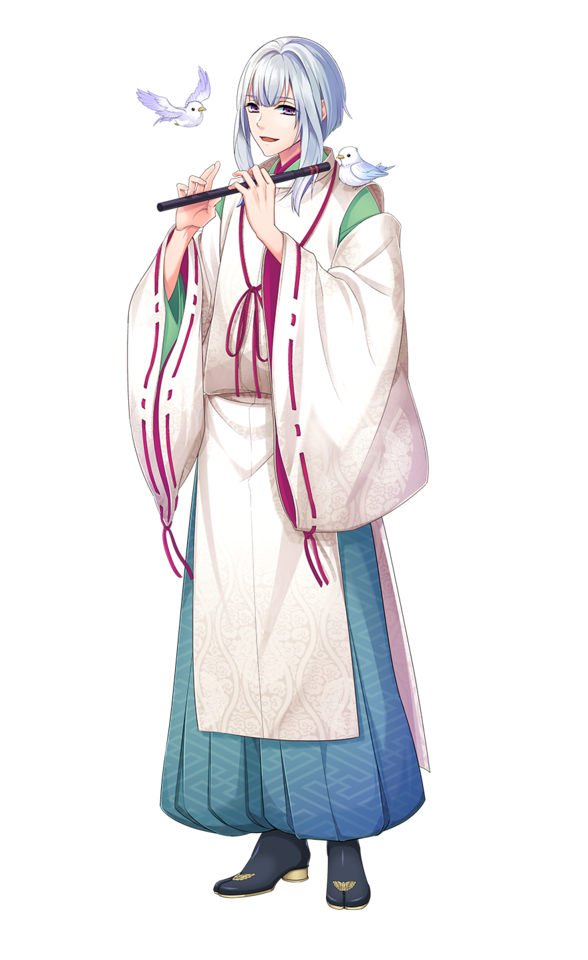

Awww~ Look at these cute twins~♡
They are Yura (older bro with twin bangs on the sides of his head) & Gaku (younger bro who really loves his ani-ue). They are the tsukumogami of musical instruments. Yura is a cursed ryuteki (dragon flute) that ‘summons death’ while Gaku is a drum. Gaku does his best to help his brother bear the burden of his curse and has spent the last one thousand years looking for a way to break it.
Sources: Here & here
10 notes
·
View notes
Text
Gagaku - Música de la Corte Imperial de Japón
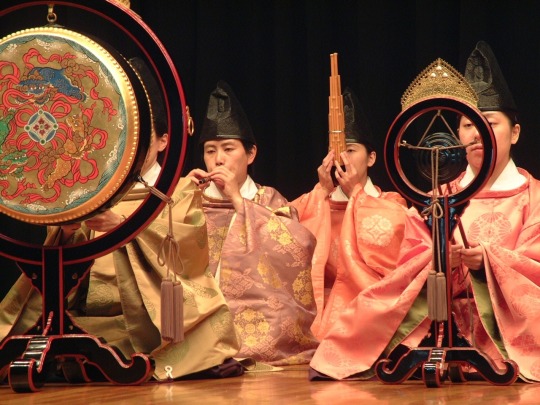
Gagaku 雅楽 literalmente significa "música elegante" es un término que originalmente se usaba en contraste con Zokugaku (música popular) Fue importada a Japón en gran parte desde China y Corea hacia el siglo VI y hacia el siglo VIII los músicos japoneses habían ya combinado estos nuevos sonidos con la música tradicional japonesa dando vida a lo que hoy conocemos como Gagaku que curiosamente ha cambiado muy poco en su forma a lo largo de su historia.
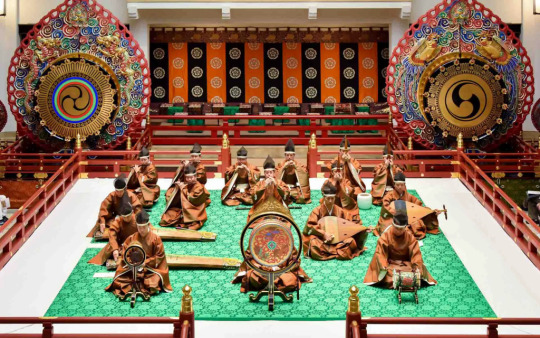
Un ensamble de Gagaku comúnmente está integrado por 16 intérpretes.
Si fueras un plebeyo en el antiguo Japón, no tendrías oportunidad de escuchar la música Gagaku ya que tenía la función de acompañar los rituales y las acciones del Emperador y la Familia Imperial y destinada a transmitir un aura de dignidad, misterio y asombro. El Gagaku se caracteriza por su música larga y lenta con movimientos parecidos a la danza comprendida en sus 3 principales estilos musicales o formas de interpretación: el Kangen (música instrumental), el Bugaku (bailes y música) y Kayō (canciones y poesía cantada) Afortunadamente ahora ya se ofrecen actuaciones para el público en general en recitales organizados por el Departamento de Música de la Casa Imperial.

En el estilo Bugaku o música de baile se omiten los instrumentos de cuerda.
Los instrumentos que más comúnmente son asociados en el Gagaku son el Sho (organillo de boca) y el Hichiriki (un tipo de oboe) Además de estos, se utilizan el Ryuteki (pequeña flauta trasversa) y Biwa (laúd de 4 cuerdas) y Koto (tipo de cítara de hasta 20 cuerdas) y las percusiones como el Taiko y el Shōkō entre otras.
Escuchar la música del Gagaku es una experiencia muy envolvente incluso relajante. Sus sonidos tan característicos te invitan a adentrarte en tus pensamientos y a disfrutar de la danza o la poesía!

El Sho y el Hichiriki son los instrumentos que más caracterizan el sonido del Gagaku
El Gagaku tiene un gran valor histórico al ser la tradición viva más antigua de música orquestal en el mundo con más de 1300 años de vida. Es considerada Propiedad Cultural Inmaterial de Japón y al mismo tiempo los músicos de la corte son reconocidos como "Propiedades Culturales Intangibles Importantes", que es una designación comúnmente conocida como "Tesoro Nacional Viviente" Al ser tan diferente en su forma y su instrumentación en comparación con la música occidental, ha ganado gran reconocimiento artístico. Su esquema de armonía y sistema de tonos tan altamente artístico ha contribuido en gran medida a la creación y desarrollo de la música contemporánea.

Los músicos del Gagaku son reconocidos como "Tesoro Nacional Viviente" y reciben un sueldo anual de cerca de 20 mil USD!
Si quieres saber cómo suena el Gagaku te recomendamos el siguiente video!
https://www.youtube.com/watch?v=5OA8HFUNfIk
Conoce más los instrumentos tradicionales de Japón como el Koto o el Shamisen en nuestros posts! Y en el siguiente video te hablamos de la música tradicional de Japón!
https://www.youtube.com/watch?v=XEZY6bMcYdk
Read the full article
0 notes